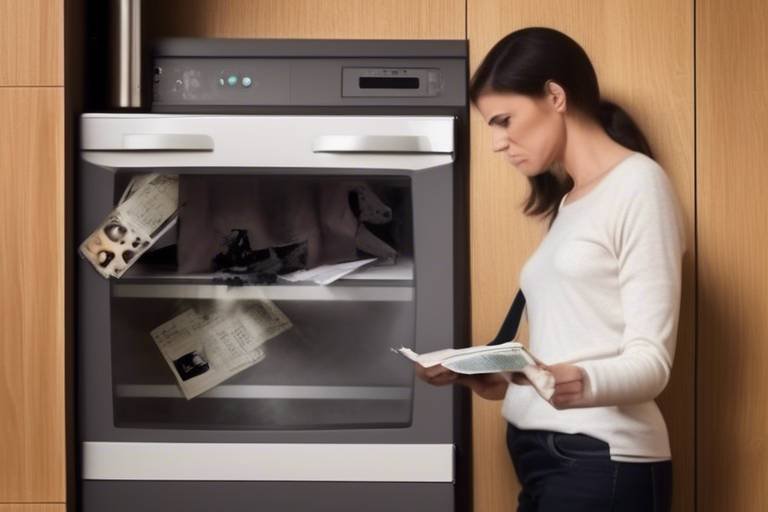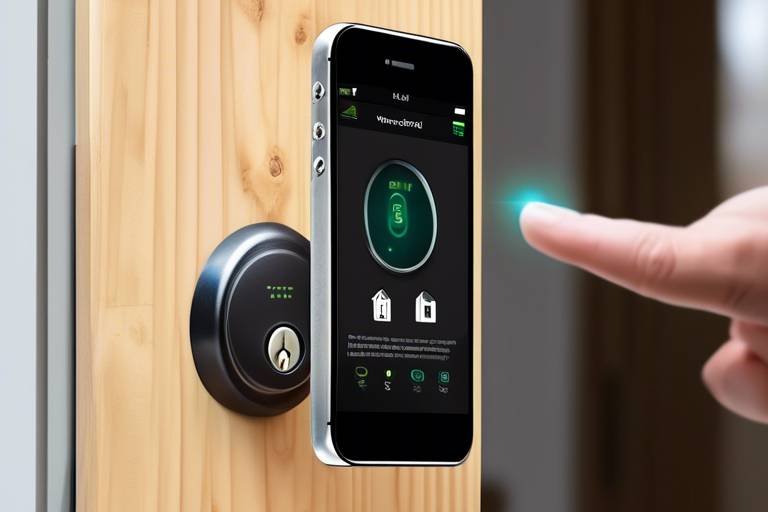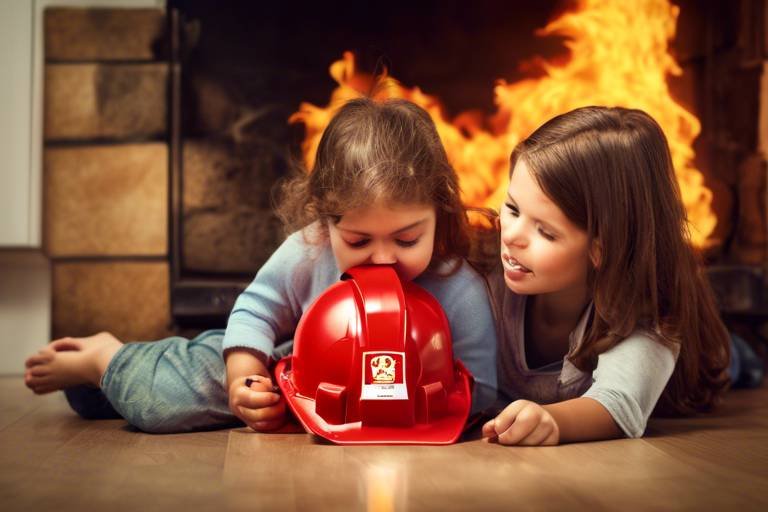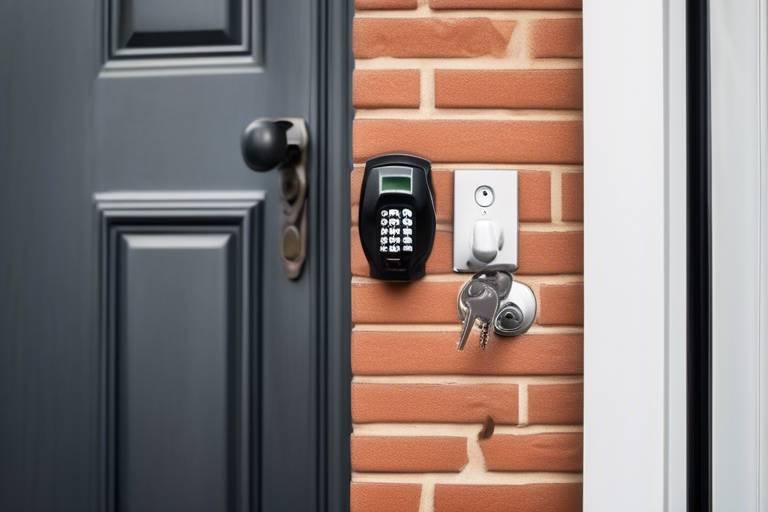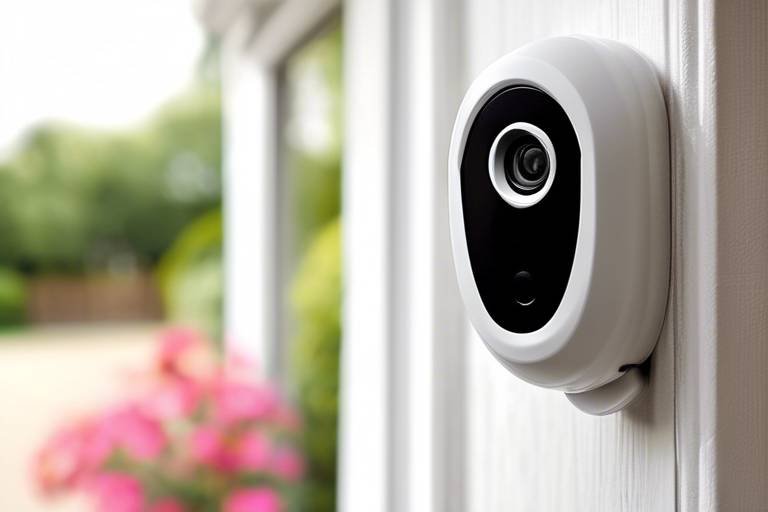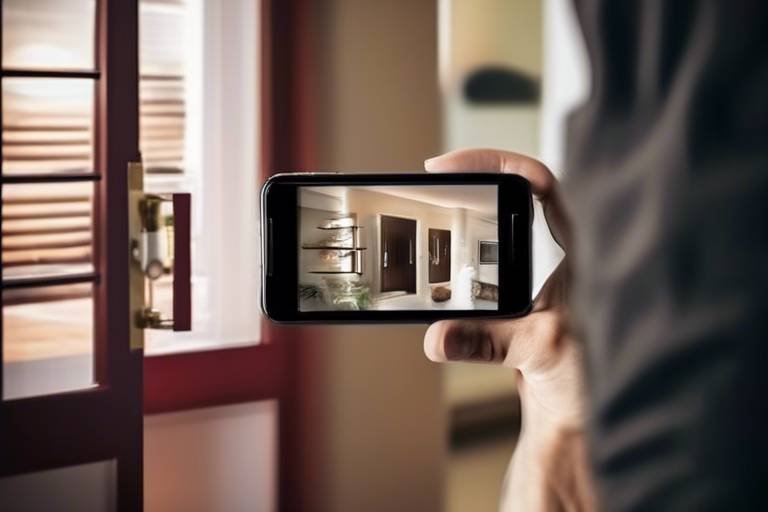Is Your Home Safe – A Self Audit
When was the last time you really looked around your home and thought about safety? We often get so caught up in our daily routines that we overlook potential hazards lurking in plain sight. Home safety is not just a buzzword; it's a vital aspect of our lives that can affect our well-being and peace of mind. Conducting a self-audit can help you uncover hidden dangers and ensure that your living environment is as safe as possible. Think of it as a health check-up for your home—just as you would visit a doctor for a physical, your home deserves the same level of care.
Imagine walking through your home with a fresh perspective, spotting not just the beautiful decor but also the risks that could lead to accidents or emergencies. A self-audit will empower you to take charge of your home’s safety and protect your loved ones. From the kitchen to the living room, every corner of your home has its own set of challenges. Are your smoke detectors functioning? Are there any loose wires that could cause a fire? These questions are essential to consider. So, grab a notepad, and let’s dive into the world of home safety!
Home safety encompasses various elements that protect occupants from accidents, injuries, and emergencies. It’s not just about having a secure front door or a well-lit driveway; it's about creating an environment where everyone feels safe and comfortable. The importance of a safe living environment cannot be overstated. A secure home allows us to relax and enjoy our lives without the constant worry of potential hazards. This is where self-audits come into play. By regularly assessing your home, you can catch issues before they become major problems.
Think of self-audits as a proactive approach to safety. Instead of waiting for an accident to happen, why not take the initiative to prevent it? Regular checks can help maintain a safe living environment and keep your family protected. So, what does a thorough self-audit involve? It’s about examining every aspect of your home, from the structure itself to the items within it. By doing so, you can identify potential hazards and implement solutions that enhance your safety.
Identifying common hazards is crucial for ensuring home safety. Many of us might be surprised to learn about the prevalent risks that could be present in our homes. Fire hazards, slip and fall risks, and electrical dangers are just a few examples of what to look out for. These risks can often go unnoticed until it’s too late, making it essential to keep your eyes peeled for potential dangers.
For instance, did you know that kitchen fires are among the most common household accidents? Or that clutter can lead to serious slip and fall accidents? Understanding these risks is the first step in mitigating them. Regularly inspecting your home for these hazards can make a significant difference in your overall safety. After all, it’s better to be safe than sorry!
Implementing effective fire safety measures can significantly reduce the risk of fire-related incidents. Having a smoke detector in every room is a must, but that's just the beginning. You also need to know where to place fire extinguishers and how to create an escape plan. A little preparation can go a long way in ensuring your family’s safety in case of a fire.
Smoke detectors are vital for early fire detection. Choosing the right detectors involves considering factors such as the size of your home and the types of rooms you have. For example, you might want to install a smoke detector in every bedroom and on each floor of your home. Regular maintenance is equally essential; remember to test your smoke detectors monthly and replace the batteries at least once a year. This simple act can mean the difference between life and death in an emergency.
A well-prepared fire escape plan can save lives. It’s not enough to simply have a plan; everyone in your household needs to know it. Practice your escape plan regularly, ensuring that everyone knows their role in an emergency. This includes identifying two exit routes from each room and a designated meeting spot outside. In a fire situation, every second counts, so having a practiced plan can make all the difference.
Slip and fall accidents are common yet preventable. Simple strategies can minimize risks, such as ensuring proper lighting in hallways and staircases, securing rugs to prevent tripping, and maintaining clear pathways. Think of your home as a safe haven; it should be free of obstacles that could lead to accidents. A little effort in these areas can significantly enhance your home’s safety.
Electrical safety is crucial for preventing fires and injuries. Regular checks can help you identify potential problems before they escalate. Inspecting wiring, outlets, and the overall condition of electrical appliances should be part of your self-audit routine. If you notice any signs of wear or damage, don’t hesitate to call a professional.
Recognizing signs of electrical issues can prevent serious hazards. Common indicators include flickering lights, warm outlets, or tripped breakers. If you experience any of these issues, it’s time to take action. Ignoring electrical problems can lead to dangerous situations, so always err on the side of caution and consult an expert when in doubt.
Childproofing is essential for families with young children. Making your home safer for kids involves practical steps such as securing heavy furniture to the wall, using outlet covers, and storing hazardous materials out of reach. It’s all about creating a safe environment where kids can explore without constant supervision. After all, kids are naturally curious and will find a way to get into things, so it’s up to us to make our homes as safe as possible.
- How often should I perform a home safety audit? It's recommended to conduct a self-audit at least twice a year, or whenever you make significant changes to your home.
- What are the most common household hazards? Common hazards include fire risks, slip and fall dangers, and electrical issues. Regular inspections can help identify these risks.
- What should I do if I find a safety hazard? Address the hazard immediately if possible. For serious issues, such as electrical problems, contact a professional.

Understanding Home Safety
Home safety is not just a buzzword; it's a fundamental aspect of our daily lives that often goes unnoticed until something goes wrong. Imagine your home as a fortress, a place where you should feel completely secure and at ease. Yet, without the right precautions, that fortress can become a breeding ground for accidents and emergencies. This is why understanding home safety is crucial. It encompasses a multitude of elements designed to protect you and your loved ones from potential hazards that could lead to injury or even worse.
So, what exactly does home safety involve? It includes everything from fire prevention measures to securing your home against intruders. Each aspect plays a vital role in creating a safe living environment. Think of it as a puzzle; every piece must fit together to create a complete picture of safety. A self-audit can serve as your magnifying glass, allowing you to scrutinize your home for any hidden dangers. By regularly assessing your living space, you can identify vulnerabilities and take proactive steps to mitigate risks.
In addition to protecting your physical space, a safe home contributes to your overall well-being. When you know that your environment is secure, you can focus on what truly matters: spending quality time with family and friends, pursuing hobbies, or simply relaxing after a long day. Home safety is not just about avoiding accidents; it's about fostering a sense of peace and tranquility. To illustrate, consider the following:
- Accidents are unpredictable: A slip on a wet floor or an electrical malfunction can happen in the blink of an eye.
- Prevention is key: Taking the time to evaluate your home can save lives and reduce injuries.
- Peace of mind: Knowing that you've taken steps to enhance safety allows you to enjoy your home fully.
Moreover, understanding home safety extends beyond just your immediate environment. It involves being aware of external factors that can impact your safety, such as neighborhood crime rates or natural disasters. For instance, living in an area prone to floods or earthquakes necessitates additional safety measures. By considering these external elements, you can create a comprehensive safety plan that addresses both internal and external risks.
In summary, understanding home safety is a multifaceted endeavor that requires ongoing attention and action. It's not a one-and-done checklist but rather a continuous process of evaluation and improvement. By taking the time to conduct a self-audit, you empower yourself and your family to live in a safer, more secure environment. Remember, safety is not just about avoiding danger; it's about creating a home where everyone feels protected and at ease.

Common Household Hazards
When it comes to ensuring the safety of your home, understanding the is the first step. Many homeowners might overlook these dangers, thinking they are minor inconveniences, but they can lead to serious accidents if not addressed. From slippery floors to faulty wiring, the risks are often lurking right under our noses. So, what should you be on the lookout for? Let's dive into some of the most prevalent hazards that could be hiding in your living space.
One of the most significant threats to home safety is fire hazards. Did you know that cooking is the leading cause of house fires? It's true! Many people leave their stovetops unattended, which can quickly lead to disaster. Additionally, overloaded electrical outlets and the presence of flammable materials like paper or cloth near heat sources can exacerbate the risk. It's essential to be vigilant about where you place your items and to ensure that your appliances are in good working condition.
Another common issue is the risk of slips and falls. These accidents can happen anywhere, but they are particularly prevalent in homes. Wet floors, loose rugs, and cluttered pathways can create dangerous situations. Imagine rushing to answer the door and suddenly slipping on a wet floor—it's a scenario that can lead to serious injuries. To combat this, make sure to keep your floors dry, secure your rugs with non-slip pads, and maintain clear walkways throughout your home.
Electrical dangers are also a major concern. Many homeowners are unaware of the potential risks associated with outdated or damaged wiring. Flickering lights, frequently tripped breakers, and the smell of burning plastic can all be indicators that something is amiss. If you notice any of these signs, it’s crucial to seek professional help immediately. Ignoring these issues can lead to electrical fires, which can be devastating.
In addition to these hazards, we must also consider the presence of toxic substances in our homes. Cleaning products, pesticides, and even some types of furniture can release harmful chemicals into the air. It's important to store these items safely and to use them according to the manufacturer’s instructions to minimize exposure. Moreover, if you have children or pets, you must be extra cautious about where you keep these substances.
Ultimately, being aware of these common household hazards is the first step toward creating a safer living environment. Regular self-audits can help you identify potential risks and take action before an accident occurs. Remember, safety is not just about reacting to incidents but proactively preventing them from happening in the first place. So, take a moment to look around your home and assess the risks that might be hiding in plain sight.
- What are the most common household hazards?
The most common household hazards include fire hazards, slip and fall risks, electrical dangers, and toxic substances.
- How can I prevent slip and fall accidents?
To prevent slip and fall accidents, keep floors dry, secure rugs, and ensure pathways are clear of clutter.
- When should I seek professional help for electrical issues?
You should seek professional help if you notice flickering lights, tripped breakers, or any unusual smells coming from outlets or appliances.
- What should I do with hazardous materials in my home?
Store hazardous materials in secure locations, use them according to instructions, and keep them out of reach of children and pets.

Fire Safety Measures
When it comes to keeping your home safe from the devastating effects of fire, implementing effective fire safety measures is not just a good idea—it's essential. Think of fire safety as the armor that protects your home and loved ones from an unforeseen disaster. Just like a knight wouldn’t venture into battle without their shield, you shouldn’t live in your home without taking the necessary precautions. So, what can you do to ensure your home is as fire-safe as possible? Let’s dive into some crucial fire safety measures that every homeowner should consider.
First and foremost, the installation of smoke detectors is vital. These little devices are your first line of defense against fire. They act like vigilant sentinels, constantly on the lookout for smoke that could indicate a fire. When choosing smoke detectors, consider the following:
- Type: Opt for ionization detectors for fast-flaming fires and photoelectric detectors for smoldering fires.
- Placement: Install them on every level of your home, inside each bedroom, and outside sleeping areas.
- Maintenance: Test your smoke detectors monthly and replace the batteries at least once a year.
Next, let’s talk about fire extinguishers. Having a fire extinguisher readily available can mean the difference between a small fire and a full-blown disaster. Place extinguishers in key areas such as the kitchen, garage, and near any potential fire hazards. But remember, simply having them isn’t enough; you need to know how to use them! Familiarize yourself with the PASS technique—Pull, Aim, Squeeze, and Sweep. This will help you act quickly and effectively in case of a fire.
Another crucial aspect of fire safety is creating a fire escape plan. Imagine this: a fire breaks out, and chaos ensues. Everyone panics, and in that moment, lives can be lost. To avoid such a scenario, you should develop a clear and concise escape plan that includes:
- Two exits from every room, if possible.
- A designated meeting place outside where everyone can gather.
- Regular practice drills with all household members to ensure everyone knows their role.
Don’t forget to educate your family about the importance of staying low to the ground to avoid smoke inhalation and how to crawl to safety. Regularly reviewing and practicing your escape plan will help everyone feel more prepared and less anxious in case of an emergency.
In addition to these measures, it’s wise to be mindful of potential fire hazards in your home. For instance, ensure that flammable materials are stored safely away from heat sources. Regularly check your appliances and wiring for any signs of wear and tear. If you notice flickering lights or frequently tripped circuit breakers, it might be time to call in a professional.
Finally, consider investing in a home fire sprinkler system. While this may sound extravagant, it could significantly reduce the risk of fire damage and save lives. Sprinklers can suppress a fire before it gets out of control, providing precious time for evacuation and reducing property loss.
In conclusion, fire safety measures are not just about installing smoke detectors and having fire extinguishers; they are about creating a culture of safety within your home. By taking proactive steps, you can ensure that your home remains a safe haven for you and your loved ones. Remember, when it comes to fire safety, an ounce of prevention is worth a pound of cure!
Q: How often should I change the batteries in my smoke detectors?
A: It’s recommended to change the batteries at least once a year. However, you should test the detectors monthly to ensure they are functioning properly.
Q: What should I do if my smoke detector goes off?
A: If your smoke detector goes off, treat it as a real fire alarm. Evacuate the house immediately and call emergency services from a safe location.
Q: Are fire escape ladders necessary?
A: If you live in a multi-story home, having a fire escape ladder can provide an additional means of escape in case of a fire.
Q: Can I use a fire extinguisher on any type of fire?
A: No, different extinguishers are designed for different types of fires. Make sure to know the type of extinguisher you have and the fires it can safely extinguish.

Smoke Detectors
When it comes to protecting your home and loved ones, are your first line of defense against fire hazards. These little devices are more than just gadgets hanging from your ceiling; they are life-saving tools that can alert you to danger long before it becomes a catastrophe. But how do you choose the right smoke detector? Where should you place them? And how do you ensure they’re always ready to go when you need them most? Let’s dive into the essentials!
First off, it’s essential to understand the types of smoke detectors available. You typically have two main options: ionization smoke detectors, which are great for detecting fast-flaming fires, and photoelectric smoke detectors, which are better at sensing smoldering fires. For the best protection, consider using both types in your home. You wouldn’t wear just one shoe, right? So why settle for one type of smoke detector?
Now, let’s talk about placement. The general rule of thumb is to install smoke detectors on every level of your home, including the basement and outside sleeping areas. Here’s a quick overview of ideal locations:
- At least 10 feet away from cooking appliances to reduce false alarms.
- On the ceiling or high on a wall, as smoke rises.
- In every bedroom to ensure alerts during sleep.
But installation is just the beginning! Regular maintenance is crucial to keeping your smoke detectors in top shape. You should test them monthly by pressing the test button and replacing the batteries at least once a year. If your smoke detector is over ten years old, it’s time for a replacement, as older models may not function effectively. Think of it like changing the oil in your car; neglecting it can lead to serious problems down the road.
Finally, creating a fire escape plan is just as important as having smoke detectors. Make sure everyone in your household knows how to react when the alarm goes off. Practice your escape routes regularly, so it becomes second nature. Remember, in an emergency, every second counts!
In summary, smoke detectors are a critical component of home safety. By choosing the right type, placing them strategically, and maintaining them regularly, you can significantly increase your chances of staying safe in the event of a fire. Don’t wait until it’s too late—take action today!
- How often should I test my smoke detectors? It’s recommended to test them monthly.
- When should I replace my smoke detectors? Replace them every 10 years or sooner if they fail to respond.
- Can I use just one type of smoke detector? For optimal safety, it’s best to use both ionization and photoelectric detectors.

Fire Escape Plans
When it comes to fire safety, having a well-prepared fire escape plan can make all the difference. Imagine being in a situation where every second counts; knowing exactly what to do can save lives. A fire escape plan isn't just a good idea; it's a necessity for every household. It should be a clear, concise strategy that outlines how everyone in the home can safely exit in the event of a fire. Here’s how to create an effective fire escape plan that everyone can understand and follow.
First, assess your home to identify all possible exits. This includes doors, windows, and any other potential escape routes. It’s essential to keep these paths clear and accessible at all times. Next, gather your family and explain the escape routes. Make sure everyone knows how to get out quickly and safely. It might be helpful to draw a simple map of your home, marking all exits and the best routes to take. This visual aid can be a great reference, especially for younger children who might panic in an emergency.
Once everyone is familiar with the escape routes, it's time to practice. Conduct regular fire drills so that everyone knows how to react when the smoke alarms go off. These drills can help reduce panic and confusion, allowing your family to exit the home swiftly. During these drills, make sure to emphasize the importance of staying low to the ground to avoid smoke inhalation and to never go back inside for personal belongings. In a fire, your life is more valuable than any material possession.
In addition to practicing escape routes, it’s crucial to establish a designated meeting place outside your home. This should be a safe distance away where everyone can gather after escaping. Having a specific spot helps ensure that all family members are accounted for and prevents anyone from re-entering the house to look for others. It can also be beneficial to inform neighbors about your plan so they can assist in case of an emergency.
Finally, review and update your fire escape plan regularly. As your family grows or changes, so too should your plan. New furniture, renovations, or changes in family dynamics can affect escape routes. Make it a habit to revisit your fire escape plan at least once a year, ensuring everyone is still familiar with it and that it remains effective. Remember, a little preparation goes a long way in ensuring your family’s safety.
In summary, creating a fire escape plan involves assessing your home, educating your family, practicing regularly, establishing a meeting point, and updating the plan as necessary. By taking these steps, you can significantly enhance your home’s safety and ensure that everyone knows how to respond in the event of a fire.
- How often should I practice my fire escape plan?
It's recommended to practice your fire escape plan at least twice a year to ensure everyone remembers the routes and procedures. - What should I do if my exit is blocked by smoke or fire?
If an exit is blocked, use an alternative route. If no exits are available, stay low to the ground to avoid smoke and signal for help from a window. - Should I include children in the planning process?
Absolutely! Involving children in the planning helps them understand the importance of the escape plan and makes them more likely to remember it during an emergency. - What if I have pets?
Include pets in your escape plan. Designate someone to be responsible for getting pets out safely, and practice this as part of your drills.

Preventing Slip and Fall Accidents
Slip and fall accidents are not just a minor inconvenience; they can lead to serious injuries and significantly impact your quality of life. Imagine walking through your home, feeling completely at ease, only to suddenly lose your footing on an unsecure rug or a cluttered pathway. It's a startling experience that can happen in the blink of an eye. To ensure your home remains a safe haven, it’s essential to take proactive measures to prevent these types of accidents.
First and foremost, proper lighting is crucial in every part of your home. Dimly lit areas can easily conceal hazards, making it difficult to navigate safely. Consider installing bright LED bulbs in hallways, staircases, and entryways. Additionally, motion sensor lights can be a fantastic addition, automatically illuminating areas when someone approaches. This way, you won’t find yourself fumbling in the dark, increasing the risk of a fall.
Another common culprit for slips and falls is unsecured rugs. While they may add a touch of decor to your space, they can also be a hidden danger. To mitigate this risk, use non-slip backing or double-sided tape to keep rugs firmly in place. If a rug is particularly troublesome, it might be best to remove it altogether. Remember, your safety should always come before aesthetics!
Moreover, keeping pathways clear is vital for maintaining a safe environment. Clutter can accumulate quickly, especially in busy households. Make it a habit to regularly declutter and organize spaces, ensuring that floors are free from toys, shoes, and other items that could cause someone to trip. In addition, consider using storage solutions like bins and baskets to keep things tidy and out of the way.
In the bathroom, where slips are most common, it’s important to take extra precautions. Install grab bars near the shower and toilet, and use non-slip mats to provide additional traction. A simple yet effective solution is to apply anti-slip strips to the bottom of the bathtub or shower. These small changes can make a world of difference in preventing accidents in one of the most hazardous areas of your home.
Lastly, if you have elderly family members or guests, it’s crucial to assess their specific needs. Consider using mobility aids, such as walkers or canes, and ensure that all areas of your home are easily accessible. By being mindful of these factors, you can create an environment that is not only safe but also welcoming for everyone.
In conclusion, preventing slip and fall accidents requires a combination of awareness, proactive measures, and regular maintenance. By taking the time to assess your home and make necessary adjustments, you can significantly reduce the risk of these accidents. Remember, a little effort goes a long way in ensuring that your home remains a safe sanctuary for you and your loved ones.
- What are the most common causes of slip and fall accidents at home?
Common causes include wet or slippery surfaces, cluttered walkways, unsecured rugs, and poor lighting.
- How can I make my bathroom safer for elderly family members?
Install grab bars, use non-slip mats, and consider using anti-slip strips in the bathtub or shower.
- Are there specific lighting recommendations for preventing falls?
Use bright LED bulbs in hallways and staircases, and consider motion sensor lights for added safety.
- What should I do if someone falls in my home?
Ensure the person is safe and comfortable, assess for injuries, and seek medical help if necessary. It's also important to document the incident for future reference.

Electrical Safety Checks
When it comes to keeping your home safe, are absolutely crucial. Many homeowners underestimate the importance of regularly inspecting their electrical systems, but neglecting this can lead to serious hazards, including fires and electrical shocks. Imagine waking up in the middle of the night to the smell of smoke, only to realize it was caused by faulty wiring. Scary, right? That’s why being proactive and performing routine checks can save you from potential disasters.
So, what should you be looking for during your electrical safety checks? First and foremost, inspect your wiring. Look for any signs of wear and tear, such as frayed cables or exposed wires. These can be red flags indicating that your electrical system is compromised. If you notice any issues, it's essential to address them immediately—don't wait until it's too late!
Next, pay attention to your outlets. Are they functioning properly? Do they feel warm to the touch? Warm outlets can indicate an overload or a short circuit, both of which can be dangerous. It's also a good idea to check for any outlets that are cracked or damaged. If you have small children, consider installing childproof outlet covers to prevent any accidents.
Another critical aspect of electrical safety is the condition of your appliances. Ensure that all your appliances are in good working order. Look for any frayed cords or signs of overheating. If you notice that an appliance frequently trips the circuit breaker, it may be time to replace it or consult a professional. Regular maintenance of your appliances can significantly reduce the risk of electrical fires.
To help you keep track of your electrical safety checks, consider creating a simple checklist. Here’s a quick overview of what to include:
- Inspect wiring for wear and tear.
- Check outlets for warmth and damage.
- Examine appliance cords for fraying.
- Test circuit breakers and fuses.
- Review the condition of extension cords and power strips.
Remember, if you ever feel uncertain about your electrical system, it’s always best to consult a licensed electrician. They can provide a comprehensive inspection and address any issues you might have overlooked. Don't let the fear of high costs deter you; investing in electrical safety is an investment in your home and family’s well-being.
In conclusion, conducting regular electrical safety checks is a vital part of maintaining a safe home environment. By being vigilant and proactive, you can identify potential hazards before they escalate into serious problems. So grab your checklist, roll up your sleeves, and take charge of your home's electrical safety today!
Q: How often should I perform electrical safety checks?
A: It’s recommended to conduct electrical safety checks at least once a year. However, if you notice any signs of wear or unusual behavior from your electrical system, don't hesitate to check more frequently.
Q: What should I do if I find a problem during my inspection?
A: If you discover any issues, such as frayed wires or malfunctioning outlets, it’s best to consult a licensed electrician to assess the situation and make necessary repairs.
Q: Are there any specific signs that indicate I need an electrical inspection?
A: Yes! Signs such as frequent circuit breaker trips, flickering lights, or outlets that feel warm to the touch are all indicators that you should schedule an electrical inspection.

Identifying Electrical Issues
When it comes to keeping your home safe, electrical issues can be some of the most serious threats lurking behind your walls. Many homeowners might not realize that flickering lights or tripped breakers are not just minor annoyances; they could be signs of significant problems that need immediate attention. Understanding these indicators can help you prevent potential hazards that could lead to fires or electrical shocks.
One of the first things to watch for is flickering lights. Have you ever been in a room where the lights seem to dance like they're at a party? While it might seem amusing, this could indicate an overloaded circuit or faulty wiring. If your lights flicker when you plug in a device, it’s a clear signal that something isn’t right. You should also keep an eye out for tripped circuit breakers. If your breaker trips frequently, it’s not just a nuisance; it’s a warning sign that your electrical system is struggling to handle the load. Ignoring these signs can lead to more severe issues down the line.
Another critical aspect to consider is the condition of your outlets. If you notice any discoloration, scorch marks, or if the outlet feels warm to the touch, it’s time to take action. These signs can indicate overheating, which poses a significant fire risk. Additionally, any outlets that are loose or do not hold plugs securely can lead to short circuits and should be replaced immediately. To give you a clearer picture, here’s a quick table summarizing common electrical issues and their potential risks:
| Issue | Potential Risk |
|---|---|
| Flickering Lights | Overloaded circuits or faulty wiring |
| Tripped Breakers | Inability to handle electrical load |
| Discolored Outlets | Overheating and fire hazard |
| Loose Outlets | Short circuits and electrical shock |
Lastly, if you hear any strange buzzing sounds coming from your outlets or light fixtures, this could be a sign of wiring issues or improper installation. Don’t ignore these sounds! They can be the precursor to a much bigger problem. If you ever feel uncertain about the state of your electrical system, it’s wise to consult a professional electrician. They can conduct a thorough inspection and provide recommendations to ensure your home remains safe and sound.
In conclusion, being proactive about identifying electrical issues can save you from potential disasters. Regular checks and being aware of the signs can make a world of difference in maintaining a safe living environment. Remember, when in doubt, it’s always better to err on the side of caution and seek professional help!
- What should I do if I notice flickering lights?
Consider consulting a qualified electrician to inspect your wiring and circuits. - How often should I check my electrical outlets?
It’s a good idea to inspect your outlets every few months for any signs of wear or damage. - Can I fix electrical issues myself?
While some minor issues can be handled by homeowners, it’s safest to hire a professional for any significant electrical problems.

Childproofing Your Home
Childproofing your home is not just a precaution; it’s a necessity for families with young children. Imagine your home as a fortress, where the safety of your little ones is the most important treasure to protect. Every corner, every room, and every item can pose a potential risk if not properly secured. So, how do you transform your living space into a safe haven for your children? Let’s dive into some practical tips that can help you achieve this goal.
First and foremost, securing heavy furniture is essential. Children are naturally curious, and they love to explore their surroundings. This can lead to climbing on furniture, which poses a serious risk of tipping. To prevent this, you can use anti-tip straps to anchor bookshelves, dressers, and cabinets to the wall. This simple yet effective measure can save you from potential accidents.
Another critical aspect of childproofing is managing electrical outlets. Young children are notorious for their fascination with plugs and sockets. To mitigate the risks, consider installing outlet covers that prevent little fingers from poking into electrical sockets. These covers are inexpensive and easy to install, providing peace of mind while ensuring your child’s safety.
Your kitchen can be a treasure trove of hazards, from sharp knives to hot stoves. It’s vital to keep cleaning supplies, medications, and any hazardous materials out of reach. A locked cabinet can be a lifesaver here. Additionally, using stove knob covers can prevent little hands from turning on the burners, making your cooking space safer. It’s all about creating a barrier between your child and potential dangers.
Don’t forget about the bathroom! This area is often overlooked when it comes to childproofing, yet it can be filled with risks. Always keep medicines and cleaning supplies stored in high cabinets. You can also invest in a non-slip mat for the bathtub to prevent falls during bath time. It’s about making every moment safe and enjoyable, especially when it comes to daily routines like bathing.
Lastly, consider the importance of educating your children about safety. While childproofing is crucial, teaching your kids about potential dangers is equally important. As they grow, they should learn to recognize hazards and understand the importance of safety rules. This knowledge can empower them to make safer choices as they explore their world.
Q: At what age should I start childproofing my home?
A: It’s best to start childproofing your home as soon as your baby begins to crawl. This usually happens around 6 to 10 months of age. The earlier you start, the safer your home will be.
Q: Are there any specific products you recommend for childproofing?
A: Yes! Some essential products include outlet covers, cabinet locks, corner guards, and anti-tip straps. Each of these items addresses specific risks and can significantly enhance your home’s safety.
Q: How often should I reassess my childproofing measures?
A: It’s a good idea to reassess your childproofing measures every few months, especially as your child grows and develops new skills. What was safe for a crawling baby may not be safe for a walking toddler.
Q: Can I childproof my home without spending a lot of money?
A: Absolutely! Many childproofing measures are affordable and can be done using household items. Simple adjustments, like rearranging furniture or using DIY solutions, can make a significant difference.
Frequently Asked Questions
- What is a home safety self-audit?
A home safety self-audit is a thorough examination of your living space to identify potential hazards that could lead to accidents or emergencies. It involves assessing various aspects of your home, including fire safety, electrical systems, and general safety measures to ensure a secure environment for all occupants.
- Why is home safety important?
Home safety is crucial because it protects you and your loved ones from accidents, injuries, and emergencies. A safe living environment reduces the risk of incidents like fires, falls, and electrical hazards, allowing you to live more comfortably and confidently in your home.
- How can I identify common household hazards?
To identify common household hazards, start by inspecting your home for potential risks. Look for fire hazards, such as overloaded outlets or unattended candles, as well as slip and fall risks like loose rugs or poor lighting. Make a checklist of areas that need attention and prioritize them for improvement.
- What fire safety measures should I implement?
Essential fire safety measures include installing smoke detectors on every level of your home, placing fire extinguishers in easily accessible locations, and creating a fire escape plan that all household members are familiar with. Regularly check and maintain these safety devices to ensure they function effectively.
- How do I maintain smoke detectors?
To maintain smoke detectors, test them monthly by pressing the test button. Replace batteries at least once a year, and consider replacing the entire unit every 10 years or as recommended by the manufacturer. Keep the detectors clean by gently vacuuming them to remove dust and debris.
- What should be included in a fire escape plan?
A fire escape plan should include designated escape routes, a meeting point outside, and assigned roles for each family member. Practice the plan regularly to ensure everyone knows what to do in case of an emergency, and make adjustments as needed based on your home's layout.
- How can I prevent slip and fall accidents?
Prevent slip and fall accidents by ensuring proper lighting in all areas, securing rugs with non-slip backing, and keeping pathways clear of clutter. Regularly check for spills and clean them up immediately to reduce the risk of falls.
- What electrical safety checks should I perform?
Key electrical safety checks include inspecting outlets for damage, ensuring wiring is in good condition, and checking appliances for any signs of wear. If you notice flickering lights or tripped breakers, it may be time to consult a professional electrician.
- How do I know if I have electrical issues?
Common signs of electrical issues include flickering lights, frequent circuit breaker trips, and outlets that feel warm to the touch. If you experience any of these symptoms, it's essential to seek professional help to avoid potential hazards.
- What are some childproofing tips for my home?
Childproofing tips include securing heavy furniture to walls, using outlet covers, and storing hazardous materials out of reach. Additionally, ensure that sharp objects and choking hazards are kept away from children to create a safer environment.

